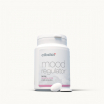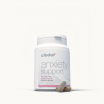What are 5 symptoms of anxiety?
Published:
Anxiety is one of the most common mental health conditions, affecting over 284 million people globally. It is characterized by excessive worrying, restlessness, fear, and tension. While anxiety is a normal emotion that everyone experiences at times, it becomes problematic when anxiety symptoms are severe, last for more than 6 months, and interfere with daily activities.
Contents:
- Excessive Worrying
- Restlessness
- Fatigue
- Irritability
- Muscle Tension
- What Causes These Anxiety Symptoms?
- Factors Influencing Symptom Severity
- Seeking Help for Anxiety Symptoms
- Conclusion:
-
Frequently Asked Questions About Anxiety Symptoms
- What are the most common symptoms of anxiety disorders?
- How are the symptoms of anxiety different from normal stress?
- Can anxiety symptoms come and go?
- Is it normal to have anxiety symptoms after a traumatic event?
- Can anxiety symptoms be different in men and women?
- What conditions are commonly co-occurring with anxiety disorders?
- What should you do if you think you may have an anxiety disorder?
- What are the most effective treatments for anxiety?
- What happens if anxiety goes untreated?
- Can natural remedies help anxiety symptoms?
- Resources used to write this article
Anxiety can present with both psychological and physical symptoms. Recognizing the signs and symptoms is the first step in getting help and treatment. Here are 5 of the most common symptoms of anxiety disorders:

1. Excessive Worrying
Excessive and uncontrollable worrying is one of the hallmark symptoms of anxiety. Individuals with anxiety often worry excessively about everyday things like health, money, family, work, or school. The worrying persists even with little or no reason to worry about these areas.
Worrying becomes problematic when it interferes with daily life, causes significant distress, and is difficult to control. Worrying also often seems disproportionate to the actual likelihood or impact of the feared event. For example, someone may excessively worry about their health even with no signs of illness.
2. Restlessness
Restlessness refers to feeling keyed up, on edge, jittery, or unable to relax. Individuals with anxiety often describe feeling “on high alert” and like something bad is about to happen, even without an actual threat present.
This restlessness can manifest both mentally and physically. Mentally, individuals may have racing thoughts or obsessive thinking about potential threats. Physically, restlessness can cause fidgeting, pacing, tremors, and difficulty sleeping. The level of restlessness is disproportionate to the actual situation.
3. Fatigue
While restlessness and high arousal are common with anxiety, many individuals also experience significant fatigue. Anxiety can be mentally exhausting, making even simple tasks feel draining.
Two factors contribute to fatigue in anxiety disorders. First, chronic worry and rumination are mentally taxing, leaving less energy for other things. Second, anxiety often causes poor sleep quality and insomnia. Tossing, turning, and disrupted sleep fail to provide proper rest.
Fatigue from anxiety can range from mild tiredness to disabling exhaustion. It often causes low motivation, difficulties concentrating, and decreased interest in normal activities.
4. Irritability
Many people with anxiety also experience increased irritability. Heightened arousal and constant worrying leave individuals feeling “on edge,” causing them to be more irritable in response to daily stressors and frustrations. Irritability may also arise from feeling unable to control anxious thoughts and feelings.
Irritability from anxiety differs from moodiness or anger caused by life stressors. The irritability stems specifically from feeling anxious and on guard. Individuals often feel bad about snapping at others but have difficulty controlling their reactions when feeling anxious.
5. Muscle Tension
Chronic anxiety causes the body to be in a heightened state of arousal, triggering physical tension, especially in the muscles. Tensing muscle groups like the jaw, shoulders, neck, and back is a common response to anxiety.
This muscle tension can manifest in multiple ways:
- Headaches
- Jaw pain from clenching
- Neck and shoulder pain
- Back pain
- Muscle spasms or twitches
The muscle tension worsens alongside increased anxiety. It may lead to pain, limited mobility, and other physical symptoms. Muscle relaxation techniques can help reduce this tension.
What Causes These Anxiety Symptoms?
These common symptoms of anxiety all stem from regions of the brain that are overactive in individuals suffering from anxiety disorders.
The amygdala is the part of the brain responsible for detecting threats and triggering the fight-or-flight response. Increased amygdala activation causes hypervigilance for potential threats, even when no danger is present. This manifests in symptoms like chronic worrying, restlessness, and muscle tension.
The prefrontal cortex controls executive functions like reasoning and decision-making. Decreased activity in this area leads to difficulties concentrating, irritability, and fatigue.
Imbalances in neurotransmitters like serotonin, dopamine, and GABA also contribute to anxiety symptoms. Medications and therapy help correct these imbalances.
Factors Influencing Symptom Severity
While these are the most common symptoms, the severity and impact of anxiety can vary greatly depending on:
Type of Anxiety Disorder
There are several types of anxiety disorders, each with overlap in symptoms but also unique features:
- Generalized anxiety disorder (GAD) involves persistent, excessive worrying about everyday life.
- Social anxiety disorder causes extreme fear of social situations and judgment.
- Panic disorder leads to sudden episodes of terror, panic attacks, and fear of recurring attacks.
- Phobias produce intense fear around specific objects or situations.
- Post-traumatic stress disorder (PTSD) develops after trauma and involves flashbacks, hypervigilance, and avoidance.
The type of anxiety disorder influences the severity and triggers for symptoms like worrying, irritability, and panic.
Comorbid Conditions
Anxiety disorders often co-occur with conditions like depression and substance abuse. The combination of multiple mental health conditions can worsen and complicate anxiety symptoms.
Early Life Experiences
Traumatic experiences in childhood, like abuse, neglect, and loss, increase vulnerability to severe anxiety disorders in adulthood. The earlier in life anxiety develops, the more severe it typically is.
Genetic Predisposition
Genes impact neurotransmitters and brain structures involved in anxiety disorders. A family history of anxiety or other mental health conditions increases people's predisposition to developing anxiety.
Environmental Stressors
Major life stressors like trauma, grief, divorce, job loss, and health conditions can trigger or exacerbate anxiety, especially in already predisposed individuals. The more stressors, the more severe symptoms tend to be.
Seeking Help for Anxiety Symptoms
If you identify with several of these symptoms consistently, reach out to a mental health professional for help. Untreated anxiety tends to worsen over time. The earlier treatment starts, the more effective it can be.
Anxiety disorders are highly treatable through medications like antidepressants and benzodiazepines, as well as psychotherapy approaches like cognitive behavioral therapy (CBT). Relaxation techniques and lifestyle changes also support treatment.
Getting control over anxiety improves quality of life dramatically. Seeking help takes courage but is the first step toward relief. You don't have to keep suffering alone. Treatment can help you manage your symptoms and start feeling better.
Conclusion:
Anxiety may show up in different ways, but common symptoms include excessive worrying, restlessness, irritability, fatigue, and muscle tension. Symptoms result from brain regions and neurotransmitters gone awry. Multiple factors like genetics, early life experiences, and environmental stress influence symptom severity. If anxiety is significantly impacting your daily life, seek professional treatment. With proper help, relief from anxiety is possible.
Frequently Asked Questions About Anxiety Symptoms
What are the most common symptoms of anxiety disorders?
The 5 most common symptoms of anxiety disorders are excessive worrying, restlessness, fatigue, irritability, and muscle tension. These stem from overactivity in parts of the brain like the amygdala and imbalances in neurotransmitters like serotonin and dopamine.
How are the symptoms of anxiety different from normal stress?
Anxiety becomes a disorder when symptoms are severe, persistent, and interfere with daily functioning. Typical stress may cause temporary worrying and irritability. With anxiety disorders, the symptoms are extreme, uncontrollable, distressing, and long-lasting.
Can anxiety symptoms come and go?
The severity of anxiety symptoms can fluctuate over time. During periods of lower stress, symptoms may improve. Increased life stress often exacerbates anxiety symptoms. Symptoms can also vary throughout the day, often being worse in the morning upon waking.
Is it normal to have anxiety symptoms after a traumatic event?
Having anxiety symptoms immediately after a traumatic event like an accident, death, or assault is common. This acute anxiety typically improves within a few weeks. If severe symptoms last over a month, it may indicate an anxiety disorder that requires treatment.
Can anxiety symptoms be different in men and women?
While excessive worrying is common for both genders, men are more prone to irritability and substance abuse while women more often experience physical symptoms like muscle tension. Women are also twice as likely to develop anxiety disorders compared to men.
What conditions are commonly co-occurring with anxiety disorders?
Anxiety often co-occurs alongside other mental health conditions like major depression, ADHD, PTSD, and substance abuse disorders. Physical conditions like thyroid disease, heart disease, and autoimmune disorders also more commonly co-occur with anxiety.
What should you do if you think you may have an anxiety disorder?
If anxiety symptoms are persistent and interfering with your life, see your primary doctor or a mental health professional. They can assess if symptoms meet the criteria for an anxiety disorder and recommend appropriate treatment options like medication, therapy, and lifestyle changes.
What are the most effective treatments for anxiety?
Cognitive behavioral therapy (CBT) is commonly used to help individuals identify and change negative thought patterns contributing to anxiety. Medications like SSRIs, SNRIs, and benzodiazepines can also help correct neurotransmitter imbalances. Relaxation techniques and adequate sleep, diet, and exercise support treatment.
What happens if anxiety goes untreated?
Untreated anxiety often worsens over time and can lead to the development of depression and substance abuse issues. Anxiety symptoms themselves can also worsen and become debilitating. Prioritizing early professional treatment provides the best opportunity to manage symptoms.
Can natural remedies help anxiety symptoms?
Some natural supplements like magnesium, omega-3s, and chamomile can modestly reduce anxiety levels for some individuals alongside professional treatment. However, these should not replace medications or therapy. Things like sufficient sleep, diet, exercise, and social connection also support anxiety treatment.
Resources used to write this article
American Psychiatric Association. (2013). Diagnostic and statistical manual of mental disorders (5th ed.). https://doi.org/10.1176/appi.books.9780890425596
Anxiety and Depression Association of America. (2018). Facts & statistics. https://adaa.org/about-adaa/press-room/facts-statistics
Bandelow, B., Michaelis, S. (2015). Epidemiology of anxiety disorders in the 21st century. Dialogues in Clinical Neuroscience, 17(3), 327-335. https://www.ncbi.nlm.nih.gov/pmc/articles/PMC4610617/
Hsieh, M. H., McQuoid, D. R., Levy, J. A. (2021). Comorbid depression and anxiety. The Medical clinics of North America, 105(4), 687–697. https://doi.org/10.1016/j.mcna.2021.04.006
National Institute of Mental Health. (n.d.). Anxiety disorders. https://www.nimh.nih.gov/health/topics/anxiety-disorders
Sartori, S. B., Singewald, N. (2019). Novel pharmacotherapeutic targets in anxiety disorders. Pharmacology & therapeutics, 200, 61–82. https://doi.org/10.1016/j.pharmthera.2019.03.006
Vogel, S., Schwabe, L. (2016). Learning and memory under stress: implications for the classroom. NPJ science of learning, 1, 16011. https://doi.org/10.1038/npjscilearn.2016.11













